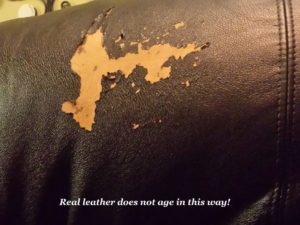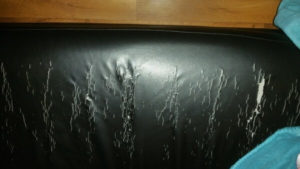Is your leather sofa peeling? Welcome to the wonderful world of “bonded leather.”
If your “leather” sofa is peeling, you do not have genuine leather made from animal hides.
Also, you do not have faux (fake) leather made with 100% polyurethane or 100% polyvinyl chloride (vinyl.)
What you do have is “Bonded leather”. This is an inferior composite material that combines a thin facing made with polyurethane, polyester or vinyl synthetic faux leathers with a backing made from compressed, granulated leather scraps.
- This “real leather” used in the Bonded leather backing is made up of left-over scraps which have been swept off the floor, chopped into tiny particles, mixed with adhesives and other chemicals and then used as the backing for a vinyl or other type of faux (synthetic) leather.
- Everything you see and touch is synthetic. All of the highly processed genuine leather is in the backing which cannot be seen or touched.
- Chopped up leather particles are a terrible backing material.
- The problem is compounded because this “processed leather” backing is thicker than a normal backing. To compensate, the synthetic face material is often thinner than what would normally be used with a cheaper (and stronger) woven cloth backing.
- Compressed leather backings do not breathe and they tend to delaminate “peel” from the vinyl. Sometimes this occurs after less than one year. It occurs frequently within 2 – 5 years.
100% synthetic faux leather materials, such as polyurethanes, polyvinylchlorides (Vinyl) and polyesters are far more durable, do not disintegrate and can cost the same or even less. They can also look and feel just as much like real leather as the bonded leathers.
Bonded leather does not look or feel any better than synthetic faux leathers. It is not necessarily less expensive. It is far less durable and frequently peels within just a few years. So why have so many furniture manufacturers and retailers insisted on using Bonded Leather?
Bonded leather is basically a Marketing Scam. It’s primary purpose was to convince uneducated customers that they were buying genuine leather furniture at deeply discounted prices.
Vinyls were first introduced in the 1930s. The material was primarily used for automobile seating until Naugahyde developed the first upholstery fabric suitable for residential seating in the 1950s. High quality vinyls, such as Naugahyde were relatively expensive as a furniture fabric. Lower cost versions were developed for popularly priced furniture.
Early lower cost vinyls were poor imitations of natural leathers. They did not look as good and they did not feel as good. It was very easy for most people to tell the difference between the synthetic imitation and the real thing.
Although faux leather technology improved over the following decades, there was still a very strong psychological resistance to “fake leather” products in furniture, all the way up to the 21st century.
The marketing genius behind Bonded Leather was the idea that, by combining a small percentage of “real leather” into the product, furniture salespeople could now convince their customers that this new material really was a type of lower cost real leather. Others implied that faux leathers made with “some real leather” were obviously superior to faux leathers made exclusively with synthetic ingredients.
The public eagerly embraced the new bonded leather materials. Demand for reclining furniture was rapidly growing. Leather was by far the most popular material purchased with this furniture category. Better looking low cost vinyls and polyurethanes were now available, but most shoppers would still not consider them.
Furniture salespeople discovered that it was very easy to convince their customers that bonded leather meant they could now purchase leather furniture for discounted prices, hundreds of dollars less than had previously been possible. Shoppers were eager to believe it was true.
Everybody would have been very happy with this small deception except for one small problem: Many bonded leathers were unstable. The thin synthetic facings delaminated from the backings, resulting in peeling fabric. There was no way to repair leather sofa peeling problems.
Despite thousands of complaints (and dozens of lawsuits,) furniture retailers were strongly resistant to the idea of dropping bonded leathers. They sold too well. So they did the next best thing. Warranties were re-worded so that manufacturers and retailers would not be financially liable for bonded leather failures.
Although the bold print on a warranty may seem to cover fabric defects during the first 12 months, they almost always have a fine print disclaimer further down expressly excluding liability for any fabric-related problems. At that point all you can do is sue the retailer. There are many lawsuits currently in litigation about bonded leathers that began to peel after a short period of time.

For example take a look at this NBC video and article. This is an interview with the CEO of a major (and highly reputable) furniture retail chain who is asked about bonded leather in response to customer complaints .
At one point, when the CEO is asked if customers are to blame for mistreating their bonded leather furniture, he replies, “I’m not saying they did something wrong, what I’m saying is that it’s delicate.”
Most consumers purchase “leather” furniture because they think it will be extremely durable. I can guarantee that none of these consumers were told by their salespeople that “bonded leather” was a “delicate” material. Or that it would result in their leather sofa peeling.
Important note also brought up in this interview — Extended warranties that customers think are protecting them for “everything” do not.
Extended warranties may even invalidate the manufacturer or retailer’s warranty.
The customer whose complaint initiated this article stated that he “paid extra for an extended warranty” but was told that “the warranty does not cover peeling leather.”

A recent editorial in Furniture Today, the leading trade publication for the furniture industry, discussed the many problems associated with bonded leather.
These included numerous lawsuits. The editor proposed that maybe it was time for bonded leather to be dropped by retailers and manufacturers throughout the industry.
Know someone who might be interested in this post? Please like and share this post with them. If you have questions or comments please leave them below.
